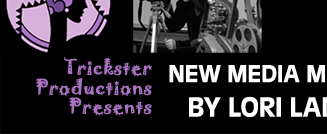







 |
 |
 |
 |
 |
|
|
 |
|
|||||
 |
 |
|
||||
|
|
|
|
|
|
|
|
Artist Statement
|
 |
The pink leopard is just about in position—yes, there! I move my “camera” to get a good shot of its eyes as they open and close, never tiring of how much its face cracks me up even though I know I probably won’t include that shot when I edit. But I am not really using a camera, but a knob device that controls my computer mouse in 3-d space in a virtual world, and I am also controlling the pink leopard avatar, as well as four others on three computers for this parody of a film noir scene, two of which I have dressed all in black and white, including their skins. Machinima—digital video captured in real-time in a virtual world or another computer-generated 3D game environment—is an interesting and at times alarming medium. Like in animation, a filmmaker is not limited by laws of physics or budget restrictions, but there are other limitations: yes, you can stage any scene you can imagine, but in the end, it is only a cartoon—at least for now. The depth of possibility, the ability to change quckly almost every aspect of any scene one is filming (lighting, costume, actor, props, time of day, location, etc.) is at once thrilling and also dizzying. That I can do almost everything (writing, production design, acting, shooting, directing) myself is similarly dazzling, and sometimes I choose to collaborate with other artists. So why, then, have I chosen to make the machinima movies I have made, and not others? Some are educational or explanatory, like “CLICK,” which I made to be able to show my students the virtual world in which I was making machinima and art without having to demo it for them. Other machinima pieces have been experiments in using it for creative documentary, whether in the piece I was asked to make for the PBS Frontline Digital Nation website, “Toggle,” which combined live action footage of me talking (a stretch to call that action, I suppose), machinima, and stills from both the actual world and Second Life to explore a friendship that moves between the virtual world and the actual one, or “The Future of Virtual Subjectivity,” which documents one of my virtual art installations. Still others, like “Avatar with a Kino Eye” or “Rethinking Virtual Commodification or, The Virtual Kitchen Sink,” use machinima as a way of expressing and visualizing ideas from my scholarship. Some are movies that use the virtual world as a set, like “Under the Sea,” imagining some pretty tough mermaids, or “Open End,” the one with the pink leopard that I was so reluctant to finish. "Time Journey" inserts my centaur avatar L1 into key moments in cinema history in a search for the key to the perfect film. "Transformation: Virtual Art on the Brink" is on a path of serious critical engagement with virtual art and then takes a surprising turn, not just considering the idea of virtual art as foreshadowing augmented reality of the future, but turning the idea of mixed reality on its head. None of this comes close to explaining, to you or to myself, why I spent eighteen months on a movie with a pink leopard, though. Part of the answer is that it cracks me up, over and over again, and that keeps me going as I work out how to tell the stories that stay half-formed until I start to laugh. Part of the answer is that I want to make someone else laugh, while at the same time telling a story and saying something meaningful about life, culture, and stories themselves. I also love playing with what is new, pushing the boundaries of my abilities, creating new challenges. It comes down to my definition of an artist: an artist is someone who shows us what we’ve not perceived before, or new things about what’s familiar. When I make machinima, I discover for myself new things all the time, and then I try to show them to you. I hone my craft to narrow that horrific, yawning gap between what I can imagine—what I can see and hear in my imagination—and what I can make manifest with the tools and resources available to me at any given moment, and I press on, manipulating the pink leopard—just so. Now that’s funny. |